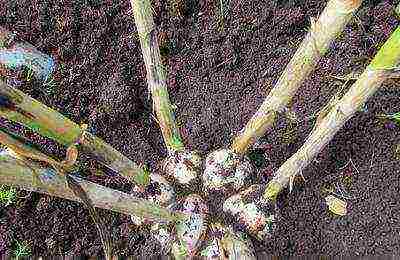Content [show]
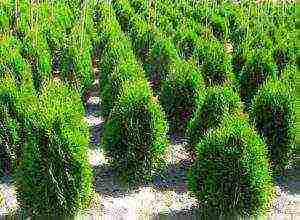
A wonderful and interesting plant thuja, planting and care in the open field of which will not cause much trouble, can be seen in many summer cottages. Conifers are especially loved by owners of personal plots and private houses, and the thuja tree is an unpretentious, frost-resistant and very beautiful plant. From it you can form figures for landscape design, decorate paths, decorate beautiful corners of the garden.
Varieties of thuja
There are many types of tui, and it will not be possible to list everything in a brief overview, so you can dwell on the most popular ones:
- The most common type of thuja is the Western thuja Smaragd. This is a tree that looks like a cypress, it can grow up to 5 m. The needles of the Western thuja are emerald in color all year round. The thuja grows in any soil, but it is more comfortable in calcareous or loamy soil. The plant is frost-resistant, areas open to sunlight or partial shade are suitable for it. It does not grow quickly and is ideal for the formation of hedges and garden figures.
- Another representative of Western thuja is Golden Smaragd. The shade of the branches casts gold, hence the name. This tree grows up to 2 m, the shoots are short and form a crown in the form of a cone. As for the land, Golden prefers fertile soil, does not like dirty city air, so it is better to plant it in the country. Poorly tolerates direct sunlight
- Western Danica is a globular shrub about 1 m in height. It grows slowly, so this species is often used as a curb or hedge.
- The Aureya variety has a yellowish color of needles - it is a dwarf shrub that does not require cutting.
- Brabant is a giant that can grow up to 20 m, and the tree grows quickly - in a year it adds up to 40 cm in height and up to 15 cm in width. The color of the needles does not change during the year and remains deep green.
Among the Eastern thujas, there are more than 50 varieties. They are more demanding, and it is a little more difficult to care for them, but with proper care of trees and shrubs, you can get a real decoration of the site. Eastern thujas are heat-resistant and tolerate drought well, stony soil is suitable for them.
Planting a tree
Thuja loves light, but if you plant it in direct sunlight, it will lose a lot of moisture, and it will be difficult for it to survive the winter. The place for the thuja must be selected light, but at noon there should be partial shade or shade, especially this rule applies to variegated and yellow thuja, otherwise their color will be pale.
It is better to plant a tree on a cloudy spring day; it is undesirable to do this in autumn, since there is no guarantee that she will have time to adapt to the new environment before winter.

Tui on the site
It is necessary to plant thuja at a distance of at least 3.5 m from each other. The size of the planting pit depends on the size of the seedling roots. The depth should be approximately 25-30 cm more than the root with a lump of earth, and the width should be 35-40 cm wider. The root collar should be level with the ground.
At the bottom of the pit, drainage and a layer of compost are laid out.Then the root of the plant is covered with a mixture of sand, turf and peat. After the hole is filled, it is necessary to compact the soil well and water the plant abundantly so that the soil is completely saturated, mulch with mowed grass, crushed tree bark and peat. This layer will protect the thrown from both heat and low temperatures. But it is worth making sure that the mulch does not cover the trunk and lower branches, otherwise they can rot.
Care after landing
How to care for thuja after planting? This plant, although drought-resistant, is also moisture-loving. In the first week after planting, it must be watered in the morning and in the evening, after the seedling takes root and grows, the plant must be watered in the summer every 5 days with 10 liters of water, and in the fall and spring it must be guided by the weather. An adult tree is watered once every 2 weeks with 30 liters of water, after 5 years it can already be watered only in hot and dry days.
Thuja care involves periodic sprinkling, while the age of the plant does not matter. So the tree receives an additional source of moisture, its foliage is freed from dust and dirt, and the air is filled with a coniferous aroma. Sprinkling can be done in the morning and in the evening, with the exception of cold nights and hot sunny days, when the moist foliage of the plant can be damaged.
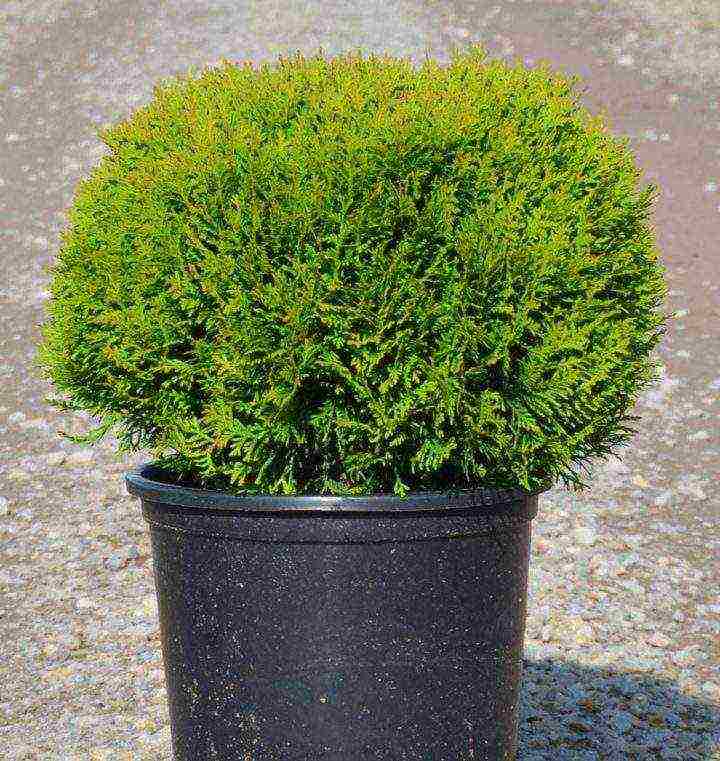
Thuja in a pot
Do not think that when pruning, damage to the plant is caused. Correct pruning is one important and necessary maintenance point. All types of thuja need pruning. If there are doubts about pruning, then it is better to contact a professional and see how he will form this shrub.
Thuja fertilizing
The care and cultivation of thuja is also the fertilization of the plant. What top dressing to use depends on the soil in which the thuja grows. You need to feed the plant if:
- it is necessary to improve the agricultural background;
- quickly provide the plant with nutrients;
- if a plant was transplanted in the fall.
Caring for thuja in the fall also involves feeding the plant. To do this, use compost, bone meal, wood ash, peat. This will help the plant to winter safely. In the spring, it is advisable to feed the thuja with organic fertilizers, the plant reacts well to mineral fertilizers - potash and nitrogen.
How to prepare thuja for winter
On summer cottages in the first year of planting for the winter, it is better to cover the thuja. You can make a bag of non-woven material (spunbond, lutrasil) and put it on the plant, making sure that the needles are not overtightened.
If the winters are snowy and windy, then you can make a wooden frame, install it around the thuja, and stretch the fabric on the frame. This will help shield the branches and prevent snow from accumulating on the top of the plant. The root system must also be insulated by preparing mulch and covering the ground around the trunk of the plant with it.
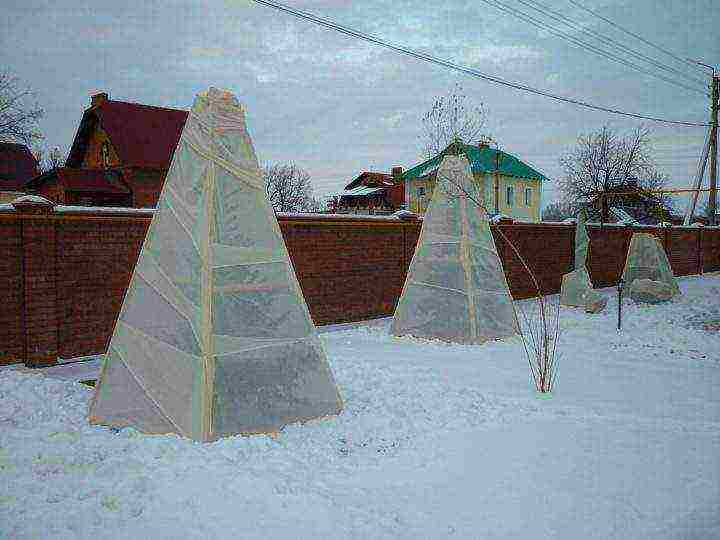
Shelter thuja for the winter
If the plant is already mature and well-rooted, then winter care will consist in removing excess snow from the branches so that the thuja foliage does not melt, and the branches do not break under the weight of the snow cover. Before the start of frost, it is necessary to water well the thuja so that the earth is moist.
When spring comes, do not rush and remove insulation and shelter - the plant must adapt. The bag must be removed on a cloudy day. When the wind dies down, you can remove the wooden frame. If the spring is sunny, it is advisable to make an awning over the thuja so that at first it is in the shade.
Thuja pests
One of the pests of the plant is the thuja aphid - tiny insects that live in large colonies and look like white dust. If the thuja was attacked, then its needles will turn yellow and fall off.
To get rid of pests, cover the ground under the plant with cellophane and rinse the affected areas with soapy water. This should be done within 1-2 weeks.
A spider mite is especially dangerous for thuja, it cannot be confused with another pest, because it envelops the plant with cobwebs. As a result, the needles become covered with yellow spots and fall off.
You can cope with a spider mite by spraying the plant with infusion of garlic or dandelion. If the lesion is too large, then use acaricides. The tick does not like moisture, so it is worth spraying it with cold water.
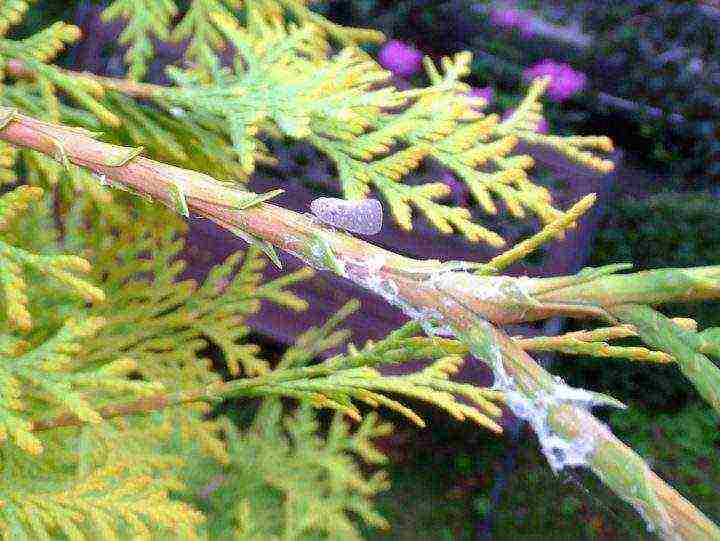
Tuya is waiting for treatment
The speckled moth gnaws thuja branches. If traces of this pest are seen, then it is better to cut off the affected branches. A completely diseased plant must be treated with pyrethroid agents.
The leafworm makes spider cocoons by weaving thuja needles into them. The drugs Profi, Fufanon or Decis will help get rid of it.
Root click beetles feed on the roots of the tree. To remove them, you can use Zemlin, Trap or Bazudin.
Thuja diseases
Fungal infection (brown shoots) manifests itself in early spring. The bark scales turn yellow and the shoots begin to die off. It is recommended to use the antifungal agent Fundazol, and remove the affected branches. In order to prevent infection of thuja with a fungal infection, it is necessary to sprinkle the roots with limestone.
Young thuja often suffer from rust. The causes of this disease may be lack of nutrition, dry air, high humidity. To prevent this disease from hitting the plant, in the spring, conifers should be sprayed with HOM.
If the needles darken and fall off, then, perhaps, she was struck by the fungal disease shute. It is also most often found in young plants. To get rid of it, it is recommended to spray the plant with Topsin-M; Bordeaux liquid can be used as a prophylaxis. With proper care and timely prevention, thuja is not as susceptible to disease as other conifers.
Among the variety of conifers, thuja is especially loved by summer residents, owners of private houses. This is not surprising - thuja is frost-resistant, unpretentious, aesthetically attractive. Planting and care in the open field will not require significant work from the summer resident, but its presence on the site will be positive from any point of view. It is great for the formation of hedges, with its help you can create unique green shapes for landscape design of the site, arrange paths.
This tree, like its coniferous counterparts, exudes a wonderful aroma, enriches the air with useful phytoncides. Thuja carries a lot of positive qualities.

Thuja differs from pine or spruce in that it has no needles, its branches are covered with small green scales, soft, pleasant to the touch. It is tacitly called the "royal tree" - it is well deserved. We will consider the nuances of planting, caring for the coniferous beauty thuja, so that it takes root on your site too.
↑ to contents ↑ Thuja tree - selection of seedlings
If you do not plan to reproduce thuja independently, then you can purchase ready-made, grown seedlings. They can be purchased from ephedra nurseries or specialist shops. There, among the declared assortment, you will choose the desired variety, buy a healthy tree, adapted to the local climate.
They can be purchased from ephedra nurseries or specialist shops. There, among the declared assortment, you will choose the desired variety, buy a healthy tree, adapted to the local climate.
Small thuja from nurseries vary in size and age. If you have a small seedling, then it will not be difficult to "grow" it yourself until it is planted in a permanent place of growth. You can also purchase a large copy, ready for the decoration of the site or the local area.
When choosing, always pay attention to the conditions of the plants, the degree of soil moisture in the containers, the strength of the coniferous scales on the branch. The branches of the seedlings should be elastic, the needles should not crumble, they should not have any spots or signs of disease. Upon arrival home, hurry up to transplant them to a shaded place, water.
↑ back to contents ↑ Planting thuja in the ground
Thuja will perfectly take root on your site at any time of the year, except in late autumn or winter. Experienced gardeners advise exactly the spring period - April, May.Planted in spring, it will hurt less, grow faster, and adapt better to the environment.
The landing site should be slightly shaded, consider this factor when planning the landscape design of the site. In direct sunlight, the tree will wither, and subsequently it will be worse to endure the winter cold. In a completely dark place, thuja will slowly develop, the branches will not be lush, bright. The ideal territory for it will be a windless section of the site, with light shading, close occurrence of groundwater.
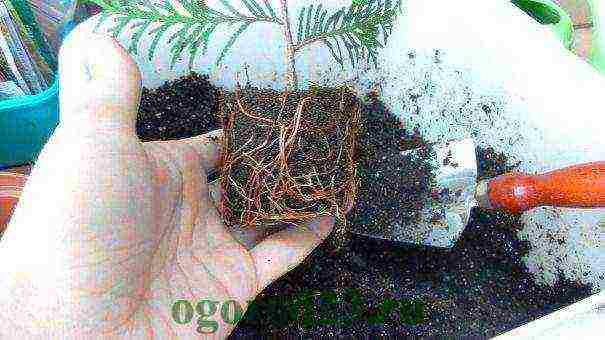
Thuja - planting and leaving, phased actions:
- First, we dig a rather deep hole - 80-100 cm deep, with the same diameter (if you, of course, have a large seedling, and not the one in the photo above). The deepening should be such that a tree with an earthen lump can freely enter there. At the bottom we pour a little earth mixed with wood ash or other organic fertilizer.
- We put it in a hole, while its root collar should be at the same level with the soil surface.
- Mix the dug earth with sand, peat (1: 1), fill a depression with a seedling with this mixture, and then slightly trample.
The distance between the trees should be determined according to the characteristics of the variety, since thuja are very small and, conversely, very tall. Small trees can be planted a meter apart, large ones - about 4-5 meters. Some varieties of thuja reach 15-20 meters in height, and their crown grows in breadth up to 3-4 meters (for example, thuja western Brabant). For full development, such a tree needs space, but when decorating alleys, green corridors, hedges, thuja are planted at a distance of 1 meter, regardless of the variety and type.
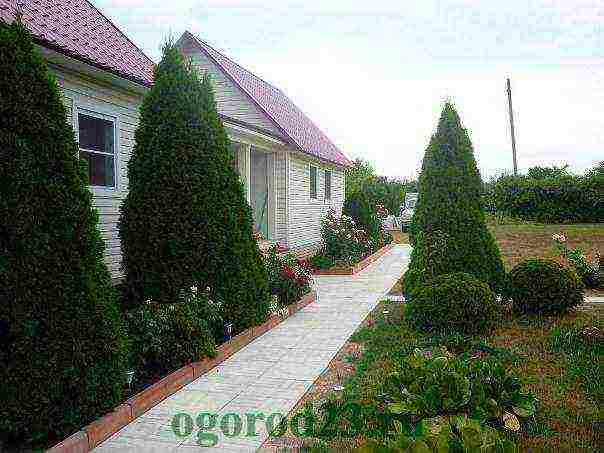 Tui Western Smaragd and globular Danica↑ back to contents ↑ How to care for thuja
Tui Western Smaragd and globular Danica↑ back to contents ↑ How to care for thuja
Competent care of this ephedra implies watering, feeding, loosening the trunk circle, and forming a crown. After the tree is planted at its permanent place of residence, primary feeding is done. For these purposes, natural growth stimulants are often used (most gardeners choose "Epin"). The components of such dressings contribute to better rooting of the tree, improve resistance to diseases. In the spring, you can feed it with potassium-phosphorus supplements, it is better to do this twice, the break between fertilizers should be 10-15 days.
In spring, the frequency of irrigation is influenced by the amount of rain, with the onset of summer it is enough 2 times a week, in the spring - 1 time. If the rains are frequent, then there is no need to water, there will be enough rain moisture. Thuja requires high-quality watering at all stages of life (seedling, adult tree), while the crown also loves irrigation. In order for the branches to be elastic, shiny, to please you with the brightness of green shades, the minimum amount of water for the root area should be 10 liters per watering (once a week, if the summer is very dry, then up to 3 times). Determine the lack of moisture by the state of the top of the thuja - it begins to turn yellow. It is better to water the trees early in the morning or in the evening.
Tuya is very fond of irrigating the crown, for these procedures, the acquisition of a special nozzle becomes relevant. From such sprinkling, dust is washed off, a fresher appearance of the tree is provided, a pleasant coniferous aroma begins to stand out. Do not be afraid to overdo it with irrigation, 1-2 times a day will only benefit thuja.
Returning to fertilizers, it is worth noting that too frequent fertilizing for thuja is not required. Special mineral compositions for conifers (for example, "Fertika") or compost, which has already become a classic additive, is enough to use twice a season - in spring and summer. Fertilizers are applied during loosening: they are laid out in a near-trunk circle, and during plowing they are mixed with the top layer of soil. In summer, the additive can be diluted with water and used for irrigation.
The near-trunk area must be periodically cleaned of weeds, loosened, mulched with sawdust or compost. Decoratively painted sawdust (they are painted with natural ingredients) or nutshells look very attractive. Mulching creates some barrier to weeds, retains moisture, and improves the condition of the tree as a whole.
As for a haircut or artistic pruning, it is better not to touch it for the first two years of a tree's life, it should take root in its place. You can start caring for the crown from the third year from the moment of planting. Initially, dried, weak branches are removed, and the degree of density is determined. Excessive thinning negatively affects the decorative qualities of the tree, everything should be in moderation.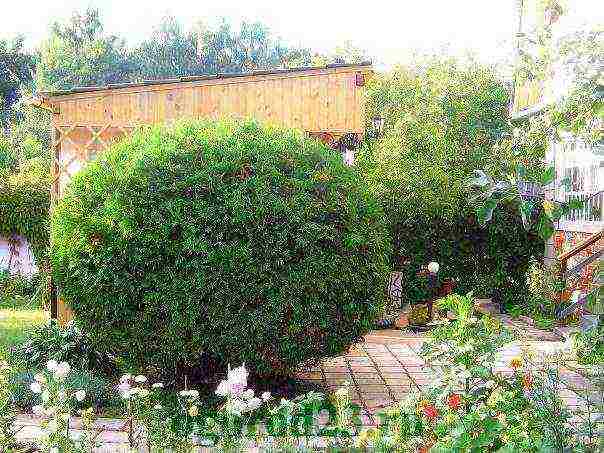
The main pruning is carried out in April, and then only the shape is corrected. For high-quality air circulation, maintaining the "vigorous" appearance of thuja, gardeners recommend removing all branches of annual growth.
If the artistic intention requires the tree to grow in breadth, then only the upper part of the crown should be trimmed. From tui, you can create various geometric shapes, columns, figures of animals or fairy-tale characters. For beginner gardeners, it is quite easy to give the crown of a tree the shape of a ball, cascade, border. Trimming or pruning is best done in dry weather.
↑ to contents ↑ Tuya - preparation for winter
For colder regions of the country, frost-resistant varieties of tui (western) should be chosen. Despite their unpretentiousness, they also require preparation for the cold season. In the fall, it is necessary to provide the trees with abundant watering, since even in winter the thuja continues to develop, albeit at a slower pace.
In the first years of life, young representatives must be insulated. With the help of a dense plastic film, non-woven spunbond or other suitable covering material, a kind of cocoon is formed, which will retain heat and let the sun's rays through. You can even buy special covers designed for this very purpose, they are sold by the garden departments of supermarkets or online stores.
For the winter, the roots are covered with fallen leaves, which are harvested with the onset of spring, as soon as the upper layer of the earth thaws. The overgrown crowns of adult thujas are neatly tied with a wide ribbon to prevent the accumulation of snow on the branches.
To please the eye, there was a healthy thuja, planting and care in the open field should be done competently, in a timely manner. This tree is quite unpretentious, but the result of simple care is expressed not only by its external beauty, decoration of the territory. A green hedge made of thuja will absorb noise from the street, neighboring territories, and also protect your site from prying eyes.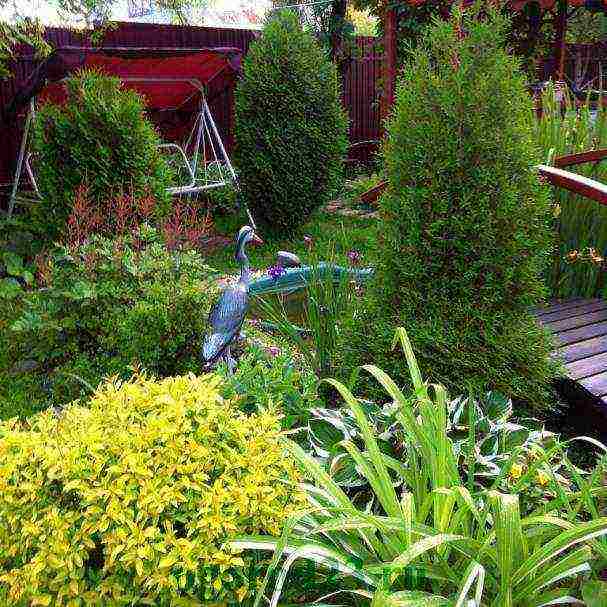
You cannot do in a summer cottage without such a popular tree today as thuja. It is no secret that a plant that is friendly to people has an unthinkable number of advantages: it pleases the eye with cheerful greenery, recalling the eternal summer, and the smell, filled with essential oils, and its decorative appearance beckons to itself (it is not for nothing that it is often used in landscape design). For keen amateur gardeners, the long-lived thuja is the pride of generations. To grow and then donate this magnificent evergreen shrub to your grandchildren and great-grandchildren, you need to know a few basic things about planting and caring for thuja in spring. All the features of growing this rather unpretentious "tree of life" are discussed in this article.

Types and varieties of thuja
There are several varieties of thuja, but the most famous are the following types:
- western (the most famous variety is Smaragd, also common are Brabant, Danica, Teddy);
- eastern.
Important! Western thuja is considered more undemanding to care. Therefore, as a rule, in our country and especially in the Central lane (Moscow region), this particular variety is grown. However, it is excellent for planting in Siberia and the Urals.
In the form of thuja there are:
- dwarf;
- columnar (pyramidal, conical);
- spherical.
As for the use of varieties of thuja in landscape design, then:
Video: popular varieties of thuja for the garden
How to choose a good thuja seedling
Thuja seedlings are most often sold with a closed root system. In this case, the seedling can either already grow in a pot (container), or be wrapped in burlap along with an earthen lump. The first option is always preferable.
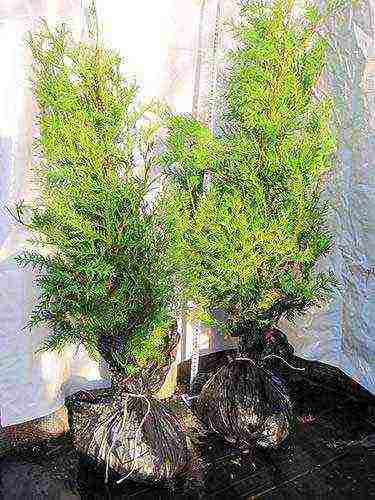
Advice! It is better to buy a younger seedling, up to about 3-4 years old. It will grow much faster than a 5-6 year old. A younger tree planted in open ground will instantly catch up and overtake a taller ephedra.

When examining a thuja seedling, you should pay attention to the following points:
- It is advisable to choose those seedlings that have a symmetrical shape.
- If the seedling is lush, then most likely its root system is good, which means it will quickly take root and grow.
- The color of the needles is usually light or dark green, with the exception of certain varieties that have a yellow or even slightly golden color of the needles. If the color of the seedling is brown, then most likely it lacks nutrients.
- If you notice strongly protruding plant roots from the drainage holes in the pot (they should stick out slightly - this is even good), then this can only mean one thing: this ephedra has not been sold for too long. You should not buy and save such a tree.
- Naturally, the trunk of the seedling should not show any damage to the bark or signs of disease.
- You can check whether the thuja is alive as follows: squeeze the needles in your hand, hold it a little and release it. If she instantly recovers and straightens up, then everything is in order with the tree.
- Another way to check the root system: take the tree by the top and lift it up. If it suddenly slips out of the pot, then most likely, the roots of the plant did not take root in an earthen coma, or the manufacturer cut them off during transplanting the seedling.
- The next tip is a little unexpected: if you notice that weeds are growing in the pot, then this is a good sign, because this means that the thuja has already wintered in this container for at least one season, and such a plant is very strong, it has adapted to our winter conditions ... And this is just a great option to buy.
- If you are allowed to get a seedling along with a clod of earth from the pot, then you should carefully consider the color of its roots. If they are white with a pinkish tint, everything is fine, but if you notice that they are brown and soft to the touch, then, unfortunately, this ephedra was poured, and the process of root rotting began.
Video: tips for choosing and buying a thuja seedling
Thuja planting technology in open ground
When to plant or planting dates
The most optimal time for planting a thuja isearly spring, even before the sap flow begins. As for the exact dates, you can do spring planting immediately after the ground warms up a little, that is, already in March-April, depending on the weather conditions in your region. This is due to the fact that it is at this time that the active phase of growth of both the coniferous shoots and its roots begins. And it is at this moment that the plant will best tolerate planting. Moreover, the root ball is likely to be slightly chilled and remain intact when planted. Plus, the plant will have plenty of time before winter to take root and grow strong roots.

You can also plant thuja summerbut it is more difficult. This ephedra is very sensitive to drying out of the roots (however, all conifers are like that), so the summer planting should be done as quickly as possible, and for this you should prepare well in advance and take everything you need.
Air temperature during landing thuja should not, if possible, be higher than 20 degrees. It is ideal to plant thuja in the morning in the summer, then the temperature is lower and the humidity is at a fairly high level.
main feature autumn planting thuja is that the ephedra has not yet developed a sufficiently powerful root system. This means that the soil in the near-trunk circle will surely sag, that is, in winter it can tilt strongly, especially during snowfall and in strong winds. So don't forget to secure the tree after planting, for example by tying it to a support.
Video: features of planting thuja in spring, summer and autumn
Place in the garden
If you can choose the most optimal place for growing thuja in your garden, then in the future you will not have to diligently care for it and deal with yellowing or shedding.
The optimal place for planting thuja - sunny area near the fence (from the grid). Thus, with a strong desire, you can grow a whole hedge. Moreover, in such a place the plant will be protected from drafts; winter dry winds affect it especially badly. In addition, having planted a tree in a slightly shaded place, the plant will receive enough sunlight for good development, and you can prevent its shoots from burning in the sun. Of course, you can plant thuja in the shade, but in such conditions it will not be able to please you with its splendor, and its needles will most likely thin out.

By the way! If you still want to grow a thuja hedge, then they should be planted at a distance of 50-60 centimeters from each other. Moreover, to obtain denser landings, it is better to plant them in 2 rows in a checkerboard pattern, while the distance in the aisles should be about 100 centimeters. So the plants will not interfere with each other and will be able to develop normally.
Naturally, you should not plant thuja where groundwater is located closer than 1 meter from the earth's surface. This ephedra loves moisture very much, but does not tolerate stagnant water.
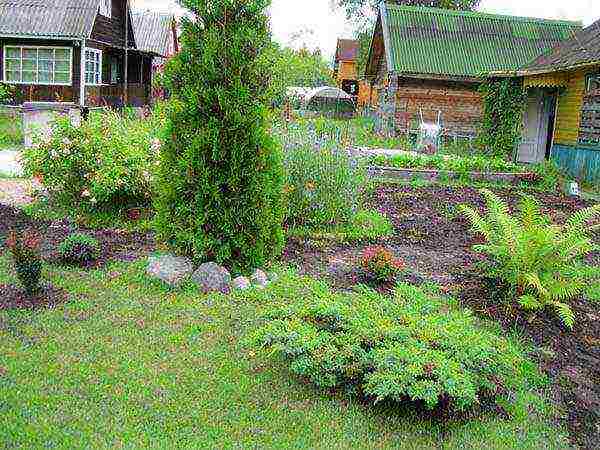
You should not choose places next to large trees with a spreading root system, in which case the thuja simply cannot grow normally, since larger trees will suppress it and take all nutrients from the soil.
Landing pit
The size of the planting pit should correspond to the size of the thuja root system and vary depending on the composition of the soil. As a rule, the diameter of the adult crown of a plant is about 1 meter, so the diameter and depth of planting should be about 80-100 centimeters. If you have light soil, then a hole can be dug 80 by 80 centimeters in size. If the soil is heavy, then 1 by 1 meter is better.
Note! Even if your seedling is small, the hole should still be large, because one must proceed from the average size of an adult plant.
The main guarantee of healthy development, rapid rooting and well-being of thuja is not only a correctly chosen planting site and a planting hole dug out for all recommendations. It also needs to be completed with a suitable potting soil.
Priming you can cook it yourself or use a ready-made option by buying land for conifers (conifers) in a specialized garden store.
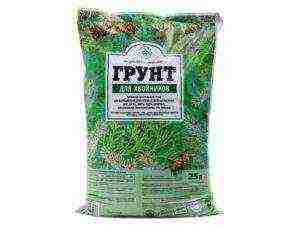
If you could not find a suitable ready-made soil, or it seemed to you that it would be cheaper to make it from individual components, then you can use the following recipes for self-preparing soil for planting thuja (for heavier soil, it is better to use recipes with sand content):
- 2 parts of sod land, 1 part of peat.
- 2 parts of sod land, 1 part of humus, 1 part of peat.
- 2 parts of sod land (or leaf), 1 part of peat, 1 part of sand and 50-100 grams of superphosphate or nitroammophos.
- 2 parts of leaf land, 2 parts of sand, 1 part of peat, 3 parts of high-quality humus.
- 3 parts of sod land, 2 parts of excellent humus and 1 part of sand.
Mix everything well and preferably (for early rooting) add another 50-60 grams (2-3 handfuls) of superphosphate or nitroammophoska to the soil mixture.Moreover, it is especially important to mix the mineral fertilizer well with the soil so that it does not burn the roots of the young plant.
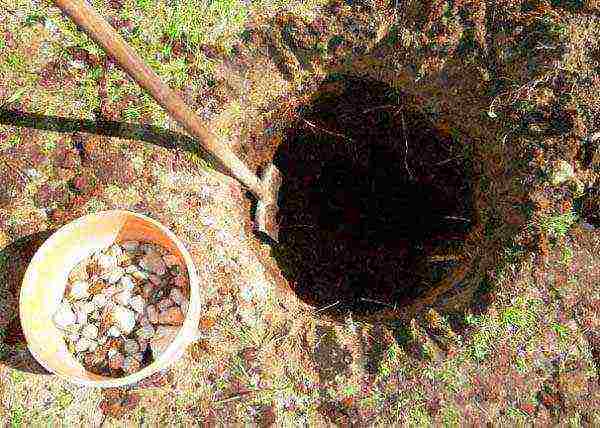
If in your summer cottage the ground is heavy and clayey (or the groundwater is too close), then in addition to digging the largest possible hole, it is very important to lay a good drainage... The required thickness of the drainage layer is about 15-25 centimeters, depending on the degree of lightness of the soil (even 10 centimeters for a very light one). You can use gravel, expanded clay, crushed stone or broken brick as drainage.
Video: secrets of growing and planting thuja
Step-by-step landing instructions
Note! Before you start planting thuja in open ground, prepare everything you need in advance (2 buckets or watering cans of water, a shovel) so as not to waste time later, because everything needs to be done quickly... You should remove the thuja from the pot only after you make a hole and a slide from the soil mixture, and also try on how it stands in it. This requirement is explained by the fact that the root system of the ephedra dries out very quickly, literally in 10-15 minutes, and this cannot be allowed.

Step-by-step instructions for planting thuja in open ground:
- Choose the best place on the site.
- Prepare, in other words, dig the required planting hole and lay drainage.
- Prepare a soil mixture according to one of the recipes or purchase ready-made soil for conifers.
- 30 minutes before planting, it is recommended to spill the pot with the plant with a root stimulator (preferably "Kornevin" or "Heteroauxin", although you can use "Epin" or "Zircon"). Such a procedure will help in the future to more conveniently and accurately get an earthen lump with a seedling.
- Throw so much soil into the hole so that when you put an earthen clod with a seedling, it will be in such a position that its root collar is 3-4 centimeters above ground level. The soil will subsequently subside, and as a result, the root collar of the plant will be at ground level. Remember that if you deeply deepen the root collar or, conversely, raise it above the ground, the plant will dry out and die.
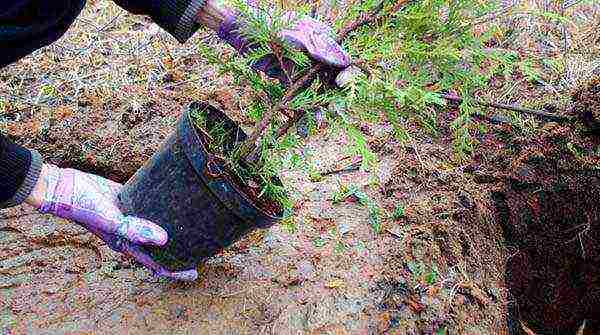
- Place the seedling on a mound in the planting hole. In order to easily remove it from the pot, put it on its side and gently tap the pot with a shovel. Then pull the seedling out by the lower part of the trunk, put it on top in the planting pit.
- Fill the hole with the remaining soil mixture by half and tamp well.
- Then you need to fill the planting hole with a bucket of water for better soil shrinkage.
- As soon as the water is absorbed, it is necessary to fill the planting hole to the top, tamp it again, make a hole for watering and pour out another bucket of water.
- The final touch is to mulch the hole for better moisture retention in the soil by 4-6 centimeters. You can use peat, compost, shredded bark, or wood chips as mulch. By the way, mulch will protect the ephedra not only from drying out, but also from overheating and freezing in winter.

It's important to know! Thuja, especially a young one, loses a lot of life-giving moisture, therefore, after planting, it is recommended to shade it with an awning made of a camouflage net or a spunbond frame. Just make sure that it does not fit snugly against the plant, otherwise it may simply mate. Moreover, if you plant thuja in the fall, then it is advisable to leave the shelter for shading until spring so that the ephedra does not get burns in the last month of winter.
Video: how to plant thuja correctly
Thuja care after planting in open ground
The main care for thuja in the open field is watering, although you should not neglect feeding. Do not forget that this ephedra should also be periodically cut and covered for the winter.
Watering thuja should be carried out systematically, especially in the first month after planting. The average plant's need for watering is about 2-3 buckets per week.When you water the newly planted thuja, the soil will settle, so you should fill it up.
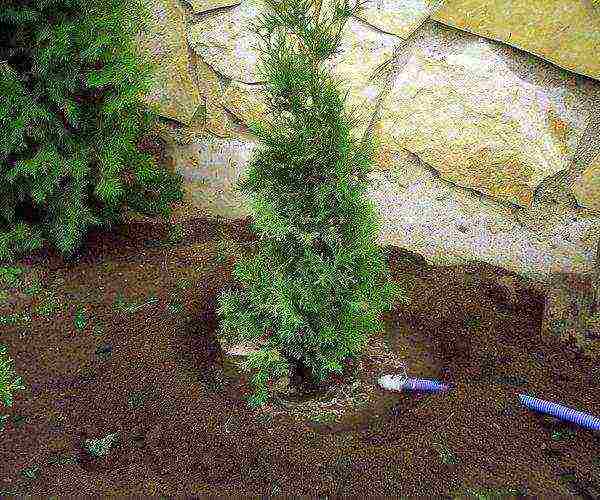
Advice! Thuja will be very grateful to you if you water it by sprinkling during hot periods, especially in dry summer weather. This will not only saturate its shoots with nutritious moisture, but also cleanse the ephedra of dust and dirt. Moreover, it is better to do this either early in the morning or in the evening when the sun goes down.

Periodically, especially after watering, the soil in the thuja trunk circle is requiredloosen (to a depth of 5-10 centimeters) and weed from weeds, so that they do not take moisture and other nutrients from the young ephedra.
Important! If you feel sorry for the water for the thuja, then it will begin to turn yellow and crumble (thin out).
The first top dressing thuja should be performed six months after planting. That is, if you plant thuja in the fall, then you should feed it this spring. For spring and early summer dressings, it is good to use urea or ammonium nitrate (just by embedding fertilizers in the soil), as well as the complex preparation "Kemira Universal". You can also use special fertilizers for conifers for feeding.
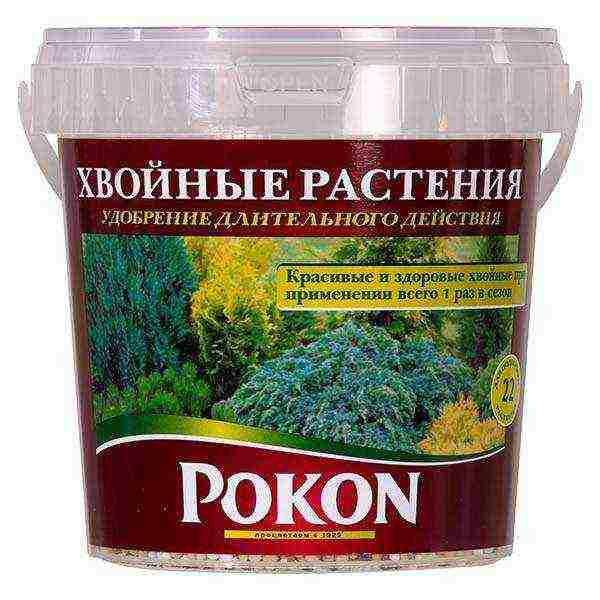
An important component in the care of thuja is its pruning... As a rule, sanitary pruning is carried out in the spring, and shaping also in the fall.
By the way! Read more about preparing thuja for winter, trimming it and covering it up, you can by this link.
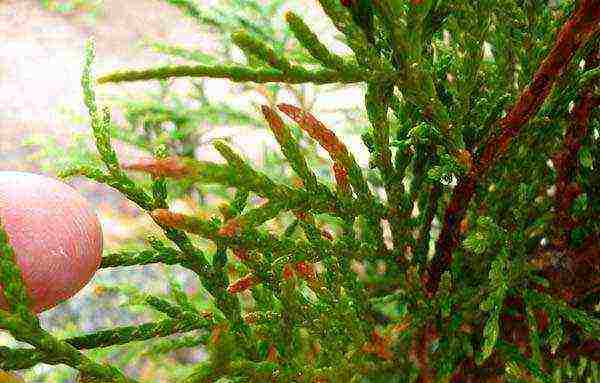
On the leaves of the thuja, you can often find this disease, like "rust". To prevent its appearance, you should use copper or iron sulfate. It should be processed in early spring or even autumn, both the inner part of the crown and the outer one. Moreover, the treatment of thuja in autumn with iron sulfate will increase its resistance to spring burns, which often occur due to snow.
Video: caring for thuja in the garden
Even a novice summer resident can effortlessly grow a beauty full of vitality on his site. You only need to direct all your energy in the right direction, taking into account all the tips and recommendations outlined in this article.
Video: Tuya Smaragd - planting, feeding and reproduction
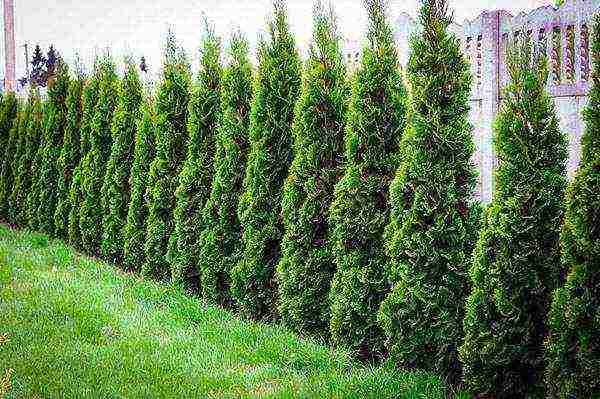 Evergreen coniferous crops are very popular due to their high decorativeness and undemandingness. Among such plants are thuja, planting and care in the open field for which even beginners can do it. In nature, thuja, the closest relatives to junipers and cypresses, are in the form of shrubs or tall trees with a dense crown and soft scaly needles.
Evergreen coniferous crops are very popular due to their high decorativeness and undemandingness. Among such plants are thuja, planting and care in the open field for which even beginners can do it. In nature, thuja, the closest relatives to junipers and cypresses, are in the form of shrubs or tall trees with a dense crown and soft scaly needles.
Cultural varieties of plants are more compact than wild ones, they can have a golden or silvery-gray crown, while thuja are not capricious, they are not afraid of polluted air and winter well in Russia.
When and how to plant an evergreen shrub? How to care for thuja in the country, and how does caring for a plant differ in different regions?
Thuja with an open root system can be planted in the ground in spring or autumn. The first option is preferable because the plant has time to acclimatize and root. In autumn, if you delay planting, there is a high risk of freezing of the bush.
 Nurseries offer closed-root seedlings. Planting such a plant is possible throughout the warm season.
Nurseries offer closed-root seedlings. Planting such a plant is possible throughout the warm season.
How to plant thuja in the spring?
 Decorative thuja love light, but constant exposure to the sun is depressing. Such a shrub turns yellow, dries up and hibernates poorly. To prevent this from happening, a bright place is chosen for the thuja, protected from the midday sun and draft.
Decorative thuja love light, but constant exposure to the sun is depressing. Such a shrub turns yellow, dries up and hibernates poorly. To prevent this from happening, a bright place is chosen for the thuja, protected from the midday sun and draft.
Thuja, unpretentious and easily growing on soils of different composition, love moisture more than other conifers, but at the same time they are afraid of stagnant water, therefore, before planting thuja in spring, they properly prepare a hole, a loose aerated substrate, and also prepare a seedling.
Thuja soil is mixed on the basis of:
- 2 pieces of litter from coniferous forest or peat;
- 3 parts of sod land;
- 2 parts of humus;
- 1 part sand.
Mineral fertilizers for conifers are mixed into the substrate, according to the recommendations of the feed manufacturer. If the soil in the country is sandy, no additional sand is added.
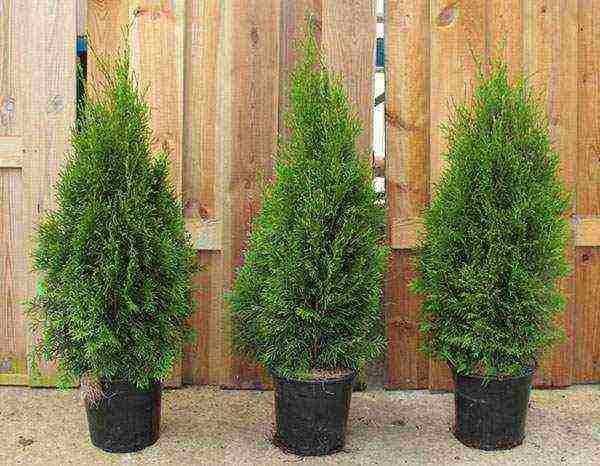 Plants with an open root system often dry out on the way to their permanent residence. To replenish strength and revive the thuja will help immersion of the roots in settled water at room temperature, to which it is useful to add a root formation stimulator.
Plants with an open root system often dry out on the way to their permanent residence. To replenish strength and revive the thuja will help immersion of the roots in settled water at room temperature, to which it is useful to add a root formation stimulator.
Plants with a closed root system, especially from foreign nurseries, can be infected with harmful fungi, scale insects, spider mites, rust pathogens and other diseases.
So that when planting thuja in Siberia, as in the photo, care does not begin with the struggle for the life of a shrub, the plant must be examined in advance and treated from roots to crown with systemic insecticides and fungicides.
Thuja planting technology in spring: a step-by-step description
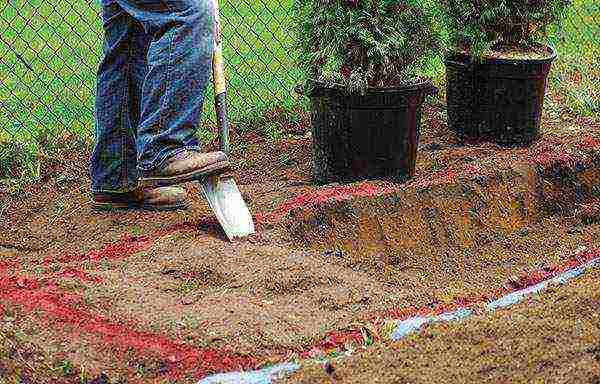 The dimensions of the planting pit depend on the dimensions of the earthen coma and the root system of the seedling. For a thuja seedling at 3-4 years of age, a pit 50 to 100 cm wide and 60-70 cm deep is required.
The dimensions of the planting pit depend on the dimensions of the earthen coma and the root system of the seedling. For a thuja seedling at 3-4 years of age, a pit 50 to 100 cm wide and 60-70 cm deep is required.
A planting hole is made at a distance of 1-3 meters from other horticultural crops. The distance depends on the selected variety. The higher the shrub, the more space and nutrition is required for its superficial root system.
How to proceed further? Summer residents who do not have experience in growing conifers will need a step-by-step description of the technology for planting thuja in the spring.
- If the site is dense, heavy soil, drainage is made at the bottom of sand, brick chips or expanded clay with a layer of 15 to 20 cm.
- Then part of the prepared soil is poured onto the bottom with a cone for a seedling with an open root system and an even layer for a plant in a container.
- A bush with a closed root system is removed from the container and placed in the center of the pit. The roots of the shrub without a container are straightened and evenly spread over an earthen cone.
- It is important that the root collar of the thuja is not below the soil level.
- When the pit is covered with soil, it is slightly compacted.
- The soil under the planted thuja is watered abundantly so that the soil is moist to the entire depth of the pit. This requires 10 to 20 liters.
- At the end, the trunk circle is mulched with chopped grass or peat.
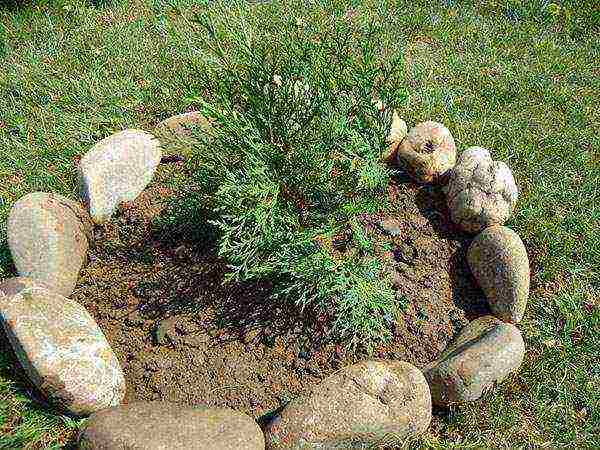 A loose protective layer of mulch will save moisture, protect the root system from decay when planting thuja and care in the Leningrad region, as well as from freezing during return cold in Siberia or the Urals.
A loose protective layer of mulch will save moisture, protect the root system from decay when planting thuja and care in the Leningrad region, as well as from freezing during return cold in Siberia or the Urals.
Thuja care after planting in the open field
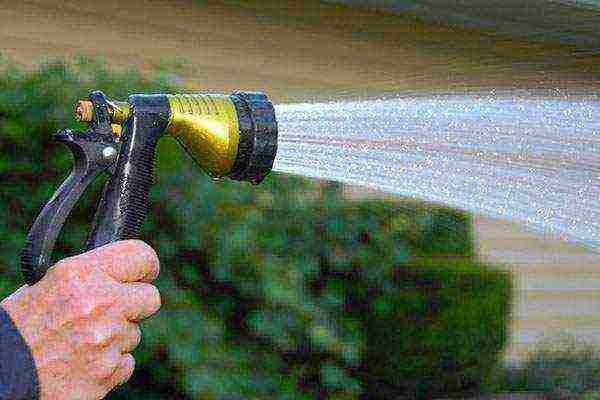
Tui respond well to water. With its lack, the shrub loses its brightness and tone, the needles gradually turn yellow, and the crown thins.
Focusing on the weather, the humidity of the air and soil, the plants in the garden are regularly watered. In dry times, this should be done every 3-4 days. Irrigating the crown in the morning or evening will help:
- keep greenery alive and beautiful;
- activate the respiration of the shoots.
Caring for thuja in the open field after planting involves removing weeds and carefully loosening the soil under the bushes. Since the roots of thuja are superficial, you should not disturb the soil deeper than 8-10 cm. Laying peat or sawdust mulch will help to simplify the task, the layer of which is renewed as needed.
Feeding thuja in spring gives the plant strength for quick recovery after wintering and activates the growth of young shoots. As a fertilizer, complex formulations for conifers with a predominance of nitrogen should be used. Liquid top dressing is applied in the morning or evening on wet soil.
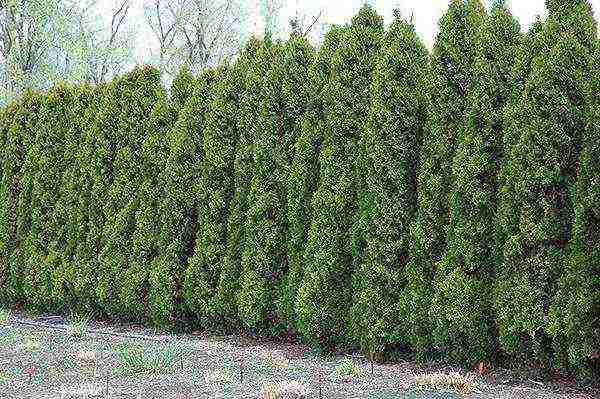 If fertilizers were added when planting in the ground, the first feeding of the thuja is carried out only two years after planting, when the soil has completely thawed. This is especially important when planting and caring for thuja in the Urals, Siberia and other regions with a harsh climate.
If fertilizers were added when planting in the ground, the first feeding of the thuja is carried out only two years after planting, when the soil has completely thawed. This is especially important when planting and caring for thuja in the Urals, Siberia and other regions with a harsh climate.
Roots in warm soil will immediately assimilate nutrients and push the growth of shoots. If fertilizers get into frozen soil, they can cause rotting of the root system.
Pruning thuja in spring
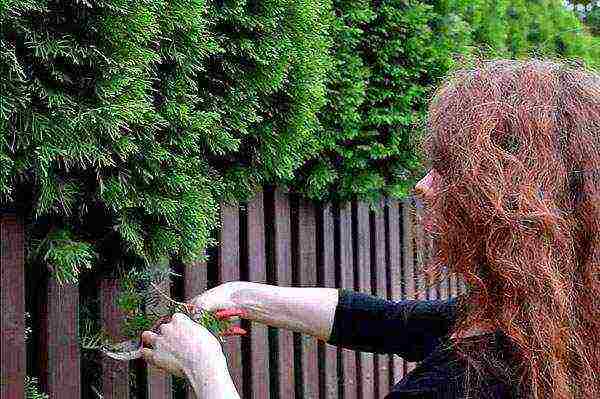 Evergreen shrubs practically do not change over the winter. In the cold season, some of the thuja varieties acquire a brown hue, their development is inhibited and resumed only with the arrival of heat.
Evergreen shrubs practically do not change over the winter. In the cold season, some of the thuja varieties acquire a brown hue, their development is inhibited and resumed only with the arrival of heat.
Caring for thujas in the spring necessarily includes sanitary pruning, which allows the crown to be freed from dry and severely damaged branches. Until the shoots have begun to grow, they carry out the spring formation of the crown. This must be done carefully, cutting off no more than a third of the length of the shoot. In the future, pruning helps to maintain the shape of the shrub, and also stimulates branching, making the plant denser, lively, green.
Hot summers can lead to the loss or weakening of some branches. In this case, do not wait for autumn. Sanitary pruning of thuja is carried out as needed. If the shoot is not dead, but only weakened, a haircut can push its recovery.
The time for re-forming the bush in the middle lane begins in August and lasts until the end of September. In Siberia, the Urals and regions where the first frosts come earlier, the haircut will have to be done earlier.
By autumn, the growth of thuja freezes, the plant prepares for winter. If the soil is dry, the plants are watered abundantly in October before the snow falls.
Preparing for cold weather and caring for thuja after winter
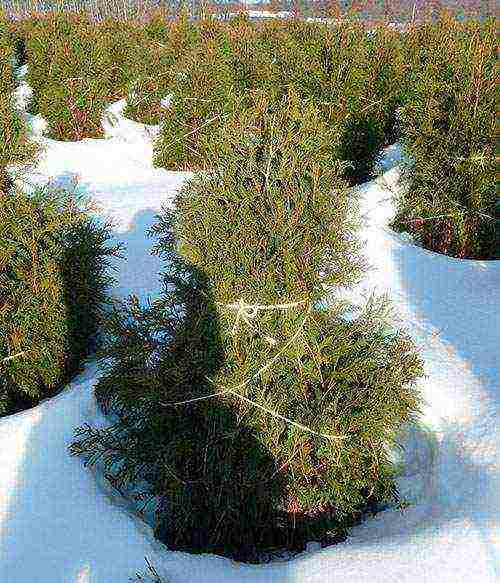 Most thuja species tolerate frosts without loss, however, young shrubs are best protected from low temperatures using spruce branches or other suitable materials. In the future, the growing shrub may not suffer from the cold, but from the breaks of the crown and burns of the needles that occur in February or March, when the snow melts and can no longer protect the branches.
Most thuja species tolerate frosts without loss, however, young shrubs are best protected from low temperatures using spruce branches or other suitable materials. In the future, the growing shrub may not suffer from the cold, but from the breaks of the crown and burns of the needles that occur in February or March, when the snow melts and can no longer protect the branches.
In Siberia, conifers lose their decorative effect both from an early spring burn and from drying out, as a result of soil freezing. These dangers are often haunted by large, tall forms. Dumplings and squat plants better tolerate even the harshest winters, but they can warm up in spring with a dense crown and prolonged thawing of the soil.
Before the onset of winter, when caring for thuja:
- carry out sanitary pruning of the crown;
- shrubs water and huddle high;
- near-trunk circles are mulched abundantly with a layer of up to 15 cm.
 For the prevention of snow breaks, pyramidal and spherical shrubs are tied up, fixing the shape with twine, but without tightening, so as to prevent the appearance of delusion.
For the prevention of snow breaks, pyramidal and spherical shrubs are tied up, fixing the shape with twine, but without tightening, so as to prevent the appearance of delusion.
Covers for evergreen wintering plants have proven themselves quite well. Snow helps to preserve the decorative effect of thuja; both tall and low plants are abundantly sprinkled with it.
Before caring for thuja in the country, you need to know the features of the various forms of this culture.
Garden thuja are divided into vigorous, medium-sized specimens and ground cover forms. Among tall plants, it winters best, retains a bright color of needles and a thuja Braband up to 20 meters high is formed. Shrubs with a narrower pyramidal shape can fade, but columnar plants, even in Siberian conditions, retain their decorative effect well. Thuja Smaragd with a height of about 2 meters with an average growth rate both in winter and in summer pleases with bright green needles, but without sufficient care it burns out.
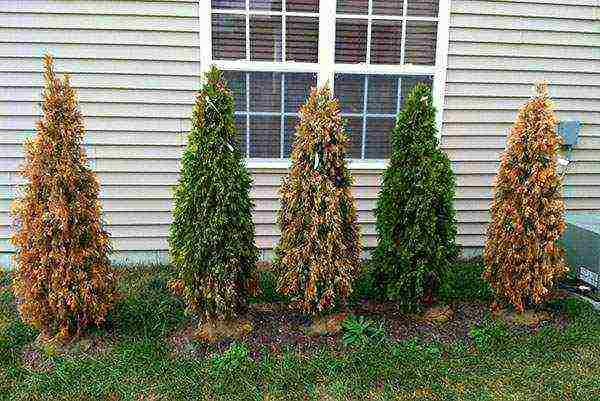 The most unpretentious and easy to care for are small plants that can be easily covered under snow and covered in spring to protect them from burns. They are good for planting and nursing in the Urals, Siberia and the Leningrad Region, where it is not always possible to grow large shrubs.
The most unpretentious and easy to care for are small plants that can be easily covered under snow and covered in spring to protect them from burns. They are good for planting and nursing in the Urals, Siberia and the Leningrad Region, where it is not always possible to grow large shrubs.
Thuja care after winter begins in February. The bright sun not only awakens everything to life, but also turns the snow into a hard crust, spoiling the bark, and burns the scaly needles. Therefore, before removing the shelter from the thuja after winter, they destroy the ice crust, and also carry out a number of measures to accelerate the thawing of the soil:
- the old mulch is removed;
- the bush is watered with hot water;
- the near-trunk circle is covered with a film or black non-woven material.
The bright spring sun is detrimental to the needles, which turn yellow and often fall off.From March to May, especially if the thuja grows in an open, sunny place, the shrub is covered with breathable material.
When the needles on the shoots are nevertheless damaged and lost their former splendor, the heavily dried, yellowed parts of the branches are cut off, and the crown is treated daily, irrigated with a solution of a growth stimulator.
Ice crust can damage the bark. After they removed the shelter for the winter, the thuja are examined, and the revealed lesions are covered with garden var.
Problems when caring for thuja outdoors
 Problems when growing thuja are most often associated with:
Problems when growing thuja are most often associated with:
- with a lack of attention;
- with the wrong planting or choosing a place for the shrub;
- weakening of the wintering field;
- attack by pests or pathogens.
Tui are affected by pathogens of fungal and bacterial infections, manifested in the form of wilting needles, the appearance of yellowness or brown spots on it. Without proper attention and complex treatment with a fungicide, the disease grows and can cause the death of the garden thuja. After primary irrigation, the procedure is repeated after 2 weeks.
Among the pests dangerous for thuja:
- shields and false shields;
- spider mites;
- thuja moth;
- aphid;
- leaf rollers;
- bark beetles damaging the bark.
As a preventive measure, plants are sprayed with an insecticide solution in early spring, repeating the treatment after 14 days.
If the thuja is planted correctly, and caring for the plant fully covers its needs, the shrub grows well and decorates the summer cottage for a long time.
Planting a thuja - video
Thuja care - video

